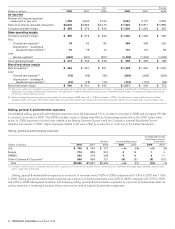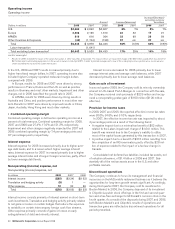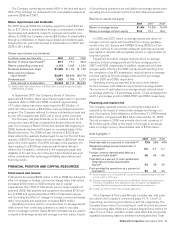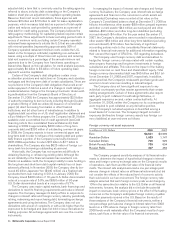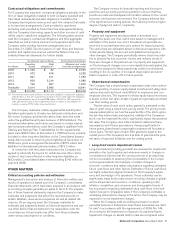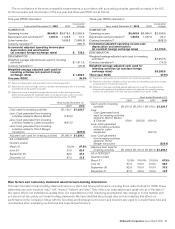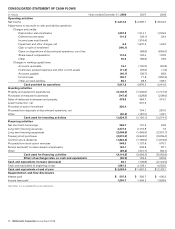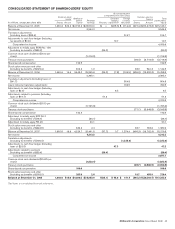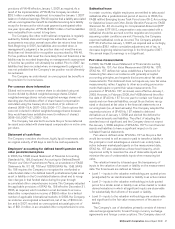McDonalds 2008 Annual Report Download - page 40
Download and view the complete annual report
Please find page 40 of the 2008 McDonalds annual report below. You can navigate through the pages in the report by either clicking on the pages listed below, or by using the keyword search tool below to find specific information within the annual report.management and, if required, the Company’s Board of Directors
have approved and committed to a plan to dispose of the assets,
the assets are available for disposal, the disposal is probable of
occurring within 12 months, and the net sales proceeds are
expected to be less than the assets’ net book value, among other
factors. An impairment charge is recognized for the difference
between the net book value of the business (including foreign
currency translation adjustments recorded in accumulated other
comprehensive income in shareholders’ equity) and the estimated
cash sales price, less costs of disposal.
An alternative accounting policy would be to recharacterize
some or all of any loss as an intangible asset and amortize it to
expense over future periods based on the term of the relevant
licensing arrangement and as revenue is recognized for royalties
and initial fees. Under this alternative for the 2007 Latam trans-
action, approximately $900 million of the $1.7 billion impairment
charge could have been recharacterized as an intangible asset and
amortized over the franchise term of 20 years, resulting in about
$45 million of expense annually. This policy would be based on a
view that the consideration for the sale consists of two compo-
nents–the cash sales price and the future royalties and initial fees.
The Company bases its accounting policy on management’s
determination that royalties payable under its developmental
license arrangements are substantially consistent with market
rates for similar license arrangements. The Company does not
believe it would be appropriate to recognize an asset for the right
to receive market-based fees in future periods, particularly given
the continuing support and services provided to the licensees.
Therefore, the Company believes that the recognition of an
impairment charge based on the net cash sales price reflects the
substance of the sale transaction.
• Litigation accruals
From time to time, the Company is subject to proceedings, lawsuits
and other claims related to competitors, customers, employees,
franchisees, government agencies, intellectual property, share-
holders and suppliers. The Company is required to assess the
likelihood of any adverse judgments or outcomes to these matters
as well as potential ranges of probable losses. A determination of
the amount of accrual required, if any, for these contingencies is
made after careful analysis of each matter. The required accrual
may change in the future due to new developments in each matter
or changes in approach such as a change in settlement strategy in
dealing with these matters. The Company does not believe that any
such matter currently being reviewed will have a material adverse
effect on its financial condition or results of operations.
• Income taxes
The Company records a valuation allowance to reduce its deferred
tax assets if it is more likely than not that some portion or all of the
deferred assets will not be realized. While the Company has
considered future taxable income and ongoing prudent and feasible
tax strategies, including the sale of appreciated assets, in assessing
the need for the valuation allowance, if these estimates and
assumptions change in the future, the Company may be required to
adjust its valuation allowance. This could result in a charge to, or an
increase in, income in the period such determination is made.
In addition, the Company operates within multiple taxing jurisdictions
and is subject to audit in these jurisdictions. The Company records
accruals for the estimated outcomes of these audits, and the accruals
may change in the future due to new developments in each matter.
During 2008, the IRS examination of the Company’s 2005-2006 U.S.
tax returns was completed. The tax provision impact associated with the
completion of this examination was not significant. During 2007, the
Company recorded a $316 million benefit as a result of the completion
of an IRS examination of the Company’s 2003-2004 U.S. tax returns.
The Company’s 2007 U.S. tax return is currently under examination and
the completion of the examination, which will ultimately include the
2008 U.S. tax return, is expected in 2011.
Deferred U.S. income taxes have not been recorded for tempo-
rary differences totaling $6.9 billion related to investments in
certain foreign subsidiaries and corporate joint ventures. The
temporary differences consist primarily of undistributed earnings
that are considered permanently invested in operations outside the
U.S. If management’s intentions change in the future, deferred
taxes may need to be provided.
Effects of changing prices—inflation
Although inflationary cost pressures increased globally in 2008,
the Company has demonstrated an ability to manage inflationary
cost increases effectively. This is because of rapid inventory turn-
over, the ability to adjust menu prices, cost controls and substantial
property holdings, many of which are at fixed costs and partly
financed by debt made less expensive by inflation.
Reconciliation of returns on incremental invested capital
Return on incremental invested capital (ROIIC) is a measure reviewed
by management over one-year and three-year time periods to eval-
uate the overall profitability of the business units, the effectiveness of
capital deployed and the future allocation of capital. This measure is
calculated using operating income and constant foreign exchange
rates to exclude the impact of foreign currency translation. The
numerator is the Company’s incremental operating income plus
depreciation and amortization, from the base period, adjusted for the
impact of the Latam transaction in 2007. While the Company has
converted certain other markets to a developmental license
arrangement, management believes the Latam transaction and the
associated charge are not indicative of ongoing operations due to the
size and scope of the transaction. Management believes that the
adjusted operating results better reflect the underlying business
trends relevant to the periods presented.
The denominator is the weighted-average adjusted cash used
for investing activities during the applicable one- or three-year
period. Adjusted cash used for investing activities is defined as
cash used for investing activities less cash generated from inves-
ting activities related to the Boston Market, Chipotle, Latam and
Pret A Manger transactions. The weighted-average adjusted cash
used for investing activities is based on a weighting applied on a
quarterly basis. These weightings are used to reflect the estimated
contribution of each quarter’s investing activities to incremental
operating income. For example, fourth quarter 2008 investing
activities are weighted less because the assets purchased have
only recently been deployed and would have generated little
incremental operating income (12.5% of fourth quarter 2008
investing activities are included in the one-year and three-year
calculations). In contrast, fourth quarter 2007 is heavily weighted
because the assets purchased were deployed more than 12
months ago, and therefore have a full year impact on 2008 operat-
ing income, with little or no impact to the base period (87.5% and
100.0% of fourth quarter 2007 investing activities are included in
the one-year and three-year calculations, respectively). Manage-
ment believes that weighting cash used for investing activities
provides a more accurate reflection of the relationship between its
investments and returns than a simple average.
38 McDonald’s Corporation Annual Report 2008




